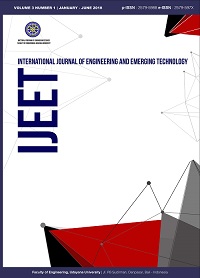Deconstruction of Mandala’s Puri Agung Karangasem
Abstract
Abstract-Deconstruction is a method, a thought as well as a theory created by Jacques Derrida, a philosopher and critic of French literature. Derrida himself was reluctant to determine exactly what deconstruction is. Derrida only mentions what is not, not what is yes. However, the thought that is currently on the decline is actually attracting the attention of architects so that his fame is revived. If you follow Derrida's way of thinking surely no one will be able to explain what deconstruction is, because once he explains that the deconstruction revealed is not deconstruction. To better recognize and understand the strategy of deconstruction in architecture, the way Bennedikt should be imitated, as a method of analyzing architectural works using the perspective of deconstruction. In this paper we will try to read an architectural work, using Bennedikt's method. The work that will be the object of reading is Puri Agung Karangasem. The main objective to be obtained through this paper is to find out whether the work can be classified into deconstruction architecture, to deepen the understanding of deconstruction itself and at the same time train sensitivity in thoroughly reviewing an architectural work through an observation angle.
Downloads
References
[2] Megawangi, I. G. A. Y., 2013. Puri Agung Karangasem: Historical Perspective, Structure and Function and its Potential as a Learning Source. Singaraja: University of Education, Ganesha.
[3] Andiani, 2014. Development Model of Agung Karangasem Castle As a Cultural Attraction of Bali. Singaraja: University of Education, Ganesha.
[4] Papadakis, A C., 1994 Architectural Design: Deconstruction in Architecture, Academy Group LTD, New Edition, London.
[5] Benedikt, M., 1991 “ Deconstructing The Kimbell, An Essay on Meaning and Architektur”, Lumen. Inc, New York.
[6] Groat, L. N., 2013. Architectural Research Methods. Hoboken, New Jersey: John Wiley & Sons, Inc.
[7] Moleong, 2010. Qualitative Research Methodology. Bandung .: PT. Rosdakaarya's teenager.
[8] Agung, A. A. P., 1986. Transition of the Bureaucratic System of the Karangasem Kingdom 1890-1983. Ygyakarta: Gajah Mada University.
[9] Salain, P. R., 2015. Puri Agung Karangasem: The Great Work of East Bali Architecture. In: Opening the Scientific Way. Denpasar: Laras Library, pp. 1-14.
[10] Gelebet, I. N., 1985. Traditional Regional Architecture of Bali. Jakarta: Ministry of Education and Culture.
[11] Dwijendra, N. K. A., 2008. Balinese Traditional House Architecture. Denpasar: Udayana University Press and CV. Bali Media Adhikarsa.
[12] Arini, A. A. A. K., 2009. Puri Karangasem Establishing Relationships with Islamic Communities and as Art Administrators. Denpasar: Denpasar Art Institute.
[13] Sulistyawati, 2008. Integration of Chinese Architecture into the Architecture of Puri Agung Karangasem. Denpasar: Udayana University Cultural Studies Postgraduate Program.
[14] Kurniawan, A., 2016. The Concept of Tourism Development for Historic Buildings in Karangasem. Denpasar, Warmadewa University.
[15] Wiweka, K., 2014. Analysis of the Tri Hita Karana Concept on the Attraction of Cultural Heritage: A Case Study of Puri Agung Karangasem, Bali. Master of Tourism Journal (JUMPA), 01 (Volume 01, Number 01, July 2014).
[16] Durmus, S. & Gur, S. O., 2011. Methodology of Deconstruction in Architectural Education. Procedia Social and Behavioral Sciences, Volume 15, pp. 1586-1594.

 Indexed By
Indexed By







